Constraints on the Geometry of Peripheral Faults above Mafic Sills in the Tarim Basin, China: Kinematic and Mechanical Approaches
Abstract
:1. Introduction
2. Geological Setting
3. Seismic Observations and Interpretation
4. Kinematic Model
4.1. Model Concept and Setup
4.2. Results of Kinematic Model
5. Limit Analysis
5.1. Model Concept and Setup
5.2. Results of Limit Analysis
6. Discussion
6.1. The Kinematics of Peripheral Faults
6.2. The Dip Angle of Peripheral Faults
6.3. The Reliability of the Trihear Model and Limit Analysis
7. Conclusions
- The trishear kinematic model successfully reproduces the geometry of peripheral faults at the sill tip and associated folds by performing a fault displacement of 58 m on a vertical fault plane with a P/S ratio of 2.5, where the fault displacement is slightly larger than the value derived from seismic interpretation;
- The seismic interpretation shows that the dip angle of the fault in the case study is 88° inward dipping. However, both the trishear kinematic model and limit analysis suggest a value of 90°. The latter is believed to better represent the actual value;
- In contrast to the classical model where the host rock deformation above mafic sills is dominated by elastic bending, the results support that peripheral faulting and associated uplifting can occur at the tips of the mafic sill as a result of sill inflation;
- Trishear kinematic modeling and limit analysis are effective methods for studying the geometry and mechanical properties of peripheral faults at the sill tips, respectively.
Supplementary Materials
Funding
Institutional Review Board Statement
Informed Consent Statement
Data Availability Statement
Acknowledgments
Conflicts of Interest
References
- Sigmundsson, F.; Parks, M.; Pedersen, R.; Jónsdóttir, K.; Ófeigsson, B.G.; Grapenthin, R.; Dumont, S.; Einarsson, P.; Drouin, V.; Heimisson, E.R.; et al. Chapter 11—Magma Movements in Volcanic Plumbing Systems and their Associated Ground Deformation and Seismic Patterns. In Volcanic and Igneous Plumbing Systems; Burchardt, S., Ed.; Elsevier: Amsterdam, The Netherlands, 2018; pp. 285–322. [Google Scholar]
- Holt, S.J.; Holford, S.P.; Foden, J. New insights into the magmatic plumbing system of the South Australian Quaternary Basalt province from 3D seismic and geochemical data. Aust. J. Earth Sci. 2013, 60, 797–817. [Google Scholar] [CrossRef]
- Schmiedel, T.; Galland, O.; Haug, Ø.T.; Dumazer, G.; Breitkreuz, C. Coulomb failure of Earth’s brittle crust controls growth, emplacement and shapes of igneous sills, saucer-shaped sills and laccoliths. Earth Planet. Sci. Lett. 2019, 510, 161–172. [Google Scholar] [CrossRef]
- Pollard, D.D.; Johnson, A.M. Mechanics of growth of some laccolithic intrusions in the Henry mountains, Utah, II: Bending and failure of overburden layers and sill formation. Tectonophysics 1973, 18, 311–354. [Google Scholar] [CrossRef]
- Bunger, A.P.; Cruden, A.R. Modeling the growth of laccoliths and large mafic sills: Role of magma body forces. J. Geophys. Res. 2011, 116, 1–18. [Google Scholar] [CrossRef]
- Francis, E.H. Magma and sediment-I Emplacement mechanism of late Carboniferous tholeiite sills in northern Britain. J. Geol. Soc. London 1982, 139, 1–20. [Google Scholar] [CrossRef]
- Malthe-Sørenssen, A.; Planke, S.; Svensen, H.; Jamtveit, B. Formation of Saucer-Shaped Sills. In Physical Geology of High-Level Magmatic Systems; Breitkreuz, C., Petford, N., Eds.; Geological Society of London Special Publication: London, UK, 2004; pp. 215–227. [Google Scholar]
- Hansen, D.M.; Cartwright, J. The three-dimensional geometry and growth of forced folds above saucer-shaped igneous sills. J. Struct. Geol. 2006, 28, 1520–1535. [Google Scholar] [CrossRef]
- Haug, Ø.T.; Galland, O.; Souloumiac, P.; Souche, A.; Guldstrand, F.; Schmiedel, T.; Maillot, B. Shear Versus Tensile Failure Mechanisms Induced by Sill Intrusions: Implications for Emplacement of Conical and Saucer-Shaped Intrusions. J. Geophys. Res. Solid. Earth 2018, 123, 3430–3449. [Google Scholar] [CrossRef]
- Haug, Ø.T.; Galland, O.; Souloumiac, P.; Souche, A.; Guldstrand, F.; Schmiedel, T. Inelastic damage as a mechanical precursor for the emplacement of saucer-shaped intrusions. Geology 2017, 45, 1099–1102. [Google Scholar] [CrossRef]
- Galland, O.; Planke, S.; Neumann, E.; Malthe-Sørenssen, A. Experimental modelling of shallow magma emplacement: Application to saucer-shaped intrusions. Earth Planet. Sci. Lett. 2009, 277, 373–383. [Google Scholar] [CrossRef]
- Polteau, S.; Mazzini, A.; Galland, O.; Planke, S.; Malthe-Sørenssen, A. Saucer-shaped intrusions: Occurrences, emplacement and implications. Earth Planet. Sci. Lett. 2008, 266, 195–204. [Google Scholar] [CrossRef]
- Amelung, F.; Jonsson, S.; Zebker, H.; Segall, P. Widespread uplift and ‘trapdoor’ faulting on Galapagos volcanoes observed with radar interferometry. Nature 2000, 407, 993–996. [Google Scholar] [CrossRef] [PubMed]
- Jónsson, S.; Zebker, H.; Amelung, F. On trapdoor faulting at Sierra Negra volcano, Galápagos. J. Volcanol. Geotherm. Res. 2005, 144, 59–71. [Google Scholar] [CrossRef]
- Acocella, V.; Di Lorenzo, R.; Newhall, C.; Scandone, R. An overview of recent (1988 to 2014) caldera unrest: Knowledge and perspectives. Rev. Geophys. 2015, 53, 896–955. [Google Scholar] [CrossRef]
- Montanari, D.; Bonini, M.; Corti, G.; Agostini, A.; Del Ventisette, C. Forced folding above shallow magma intrusions: Insights on supercritical fluid flow from analogue modelling. J. Volcanol. Geotherm. Res. 2017, 345, 67–80. [Google Scholar] [CrossRef]
- Planke, S.; Rasmussen, T.; Rey, S.S.; Myklebust, R. Seismic Characteristics and Distribution of Volcanic Intrusions and Hydrothermal Vent Complexes in the Vøring and Møre Basins. In Petroleum Geology: North-West Europe and Global Perspectives, Proceedings of the 6th Petroleum Geology Conference, London, UK, 6–9 October 2003; Geological Society of London: London, UK, 2005. [Google Scholar]
- Yao, Z. Spatial and Temporal Distribution of Igneous Sills in the Central Tarim Basin and Their Geological Implications. Minerals 2024, 14, 862. [Google Scholar] [CrossRef]
- Zheng, Y.; Blackstone, L.; Segall, P. Constraints on Absolute Magma Chamber Volume from Geodetic Measurements of Trapdoor Faulting at Sierra Negra Volcano, Galapagos. Geophys. Res. Lett. 2022, 49, e2021GL095683. [Google Scholar] [CrossRef]
- Vasco, D.W. Invariance, groups, and non-uniqueness: The discrete case. Geophys. J. Int. 2007, 168, 473–490. [Google Scholar] [CrossRef]
- Galetto, F.; Bagnardi, M.; Acocella, V.; Hooper, A. Noneruptive Unrest at the Caldera of Alcedo Volcano (Galápagos Islands) Revealed by InSAR Data and Geodetic Modeling. J. Geophys. Res. Solid. Earth 2019, 124, 3365–3381. [Google Scholar] [CrossRef]
- Yao, Z.; He, G.; Li, C.; Dong, C. Sill geometry and emplacement controlled by a major disconformity in the Tarim Basin, China. Earth Planet. Sci. Lett. 2018, 501, 37–45. [Google Scholar] [CrossRef]
- Cong, F.; Tian, J.; Hao, F.; Wang, Q.; Liu, J.; Cao, Z. Differential petroleum charging controlled by movements of two strike-slip faults in the Shunbei area, Tarim Basin, northwestern China. Am. Assoc. Pet. Geol. Bull. 2024, 108, 877–906. [Google Scholar] [CrossRef]
- Kang, Y.Z.; Kang, Z.H. Tectonic evolution and oil and gas of Tarim basin. J. Southeast Asian Earth Sci. 1996, 13, 317–325. [Google Scholar]
- Lin, C.; Yang, H.; Liu, J.; Rui, Z.; Cai, Z.; Zhu, Y. Distribution and erosion of the Paleozoic tectonic unconformities in the Tarim Basin, Northwest China: Significance for the evolution of paleo-uplifts and tectonic geography during deformation. J. Asian Earth Sci. 2012, 46, 1–19. [Google Scholar] [CrossRef]
- Xu, Y.; Wei, X.; Luo, Z.; Liu, H.; Cao, J. The Early Permian Tarim Large Igneous Province: Main characteristics and a plume incubation model. Lithos 2014, 204, 20–35. [Google Scholar] [CrossRef]
- Yu, X.; Yang, S.; Chen, H.; Chen, Z.; Li, Z.; Batt, G.E.; Li, Y. Permian flood basalts from the Tarim Basin, Northwest China: SHRIMP zircon U–Pb dating and geochemical characteristics. Gondwana Res. 2011, 20, 485–497. [Google Scholar] [CrossRef]
- Li, Z.; Chen, H.; Song, B.; Li, Y.; Yang, S.; Yu, X. Temporal evolution of the Permian large igneous province in Tarim Basin in northwestern China. J. Asian Earth Sci. 2011, 42, 917–927. [Google Scholar] [CrossRef]
- Yang, S.; Chen, H.; Li, Z.; Li, Y.; Yu, X.; Li, D. Early Permian Tarim Large Igneous Province in northwest China. Sci. China Earth Sci. 2014, 44, 187–199, (In Chinese with English Abstract). [Google Scholar] [CrossRef]
- Tian, W.; Li, X.; Wang, L. Forced Fold Amplitude and Sill Thickness Constrained by Wireline and 3-D Seismic Data Suggest an Elastic Magma-Induced Deformation in Tarim Basin, NW China. Minerals 2021, 11, 293. [Google Scholar] [CrossRef]
- Erslev, E.A. Trishear fault-propagation folding. Geology 1991, 19, 617–620. [Google Scholar] [CrossRef]
- Cardozo, N.; Bhalla, K.; Zehnder, A.T.; Allmendinger, R.W. Mechanical models of fault propagation folds and comparison to the trishear kinematic model. J. Struct. Geol. 2003, 25, 1–18. [Google Scholar] [CrossRef]
- Allmendinger, R.W. Inverse and forward numerical modeling of trishear fault-propagation folds. Tectonics 1998, 17, 640–656. [Google Scholar] [CrossRef]
- Guldstrand, F.; Burchardt, S.; Hallot, E.; Galland, O. Dynamics of Surface Deformation Induced by Dikes and Cone Sheets in a Cohesive Coulomb Brittle Crust. J. Geophys. Res. Solid. Earth 2017, 122, 8511–8524. [Google Scholar] [CrossRef]
- Souloumiac, P.; Krabbenhøft, K.; Leroy, Y.M.; Maillot, B. Failure in accretionary wedges with the maximum strength theorem: Numerical algorithm and 2D validation. Comput. Geosci. 2010, 14, 793–811. [Google Scholar] [CrossRef]
- Schellart, W.P. Shear test results for cohesion and friction coefficients for different granular materials; scaling implications for their usage in analogue modelling. Tectonophysics 2000, 324, 1–16. [Google Scholar] [CrossRef]
- Jónsson, S. Stress interaction between magma accumulation and trapdoor faulting on Sierra Negra volcano, Galápagos. Tectonophysics 2009, 471, 36–44. [Google Scholar] [CrossRef]
- Sandanbata, O.; Watada, S.; Satake, K.; Kanamori, H.; Rivera, L.; Zhan, Z. Sub-Decadal Volcanic Tsunamis Due to Submarine Trapdoor Faulting at Sumisu Caldera in the Izu–Bonin Arc. J. Geophys. Res. Solid. Earth 2022, 127, e2022JB024213. [Google Scholar] [CrossRef]
- de Saint-Blanquat, M.; Habert, G.; Horsman, E.; Morgan, S.S.; Tikoff, B.; Launeau, P.; Gleizes, G. Mechanisms and duration of non-tectonically assisted magma emplacement in the upper crust: The Black Mesa pluton, Henry Mountains, Utah. Tectonophysics 2006, 428, 1–31. [Google Scholar] [CrossRef]
- Wilson, P.I.R.; McCaffrey, K.J.W.; Wilson, R.W.; Jarvis, I.; Holdsworth, R.E. Deformation structures associated with the Trachyte Mesa intrusion, Henry Mountains, Utah: Implications for sill and laccolith emplacement mechanisms. J. Struct. Geol. 2016, 87, 30–46. [Google Scholar] [CrossRef]
- Wessel, P.; Smith, W.H.F.; Scharroo, R.; Luis, J.; Wobbe, F. Generic Mapping Tools: Improved Version Released. Eos Trans. Am. Geophys. Union. 2013, 94, 409–410. [Google Scholar] [CrossRef]

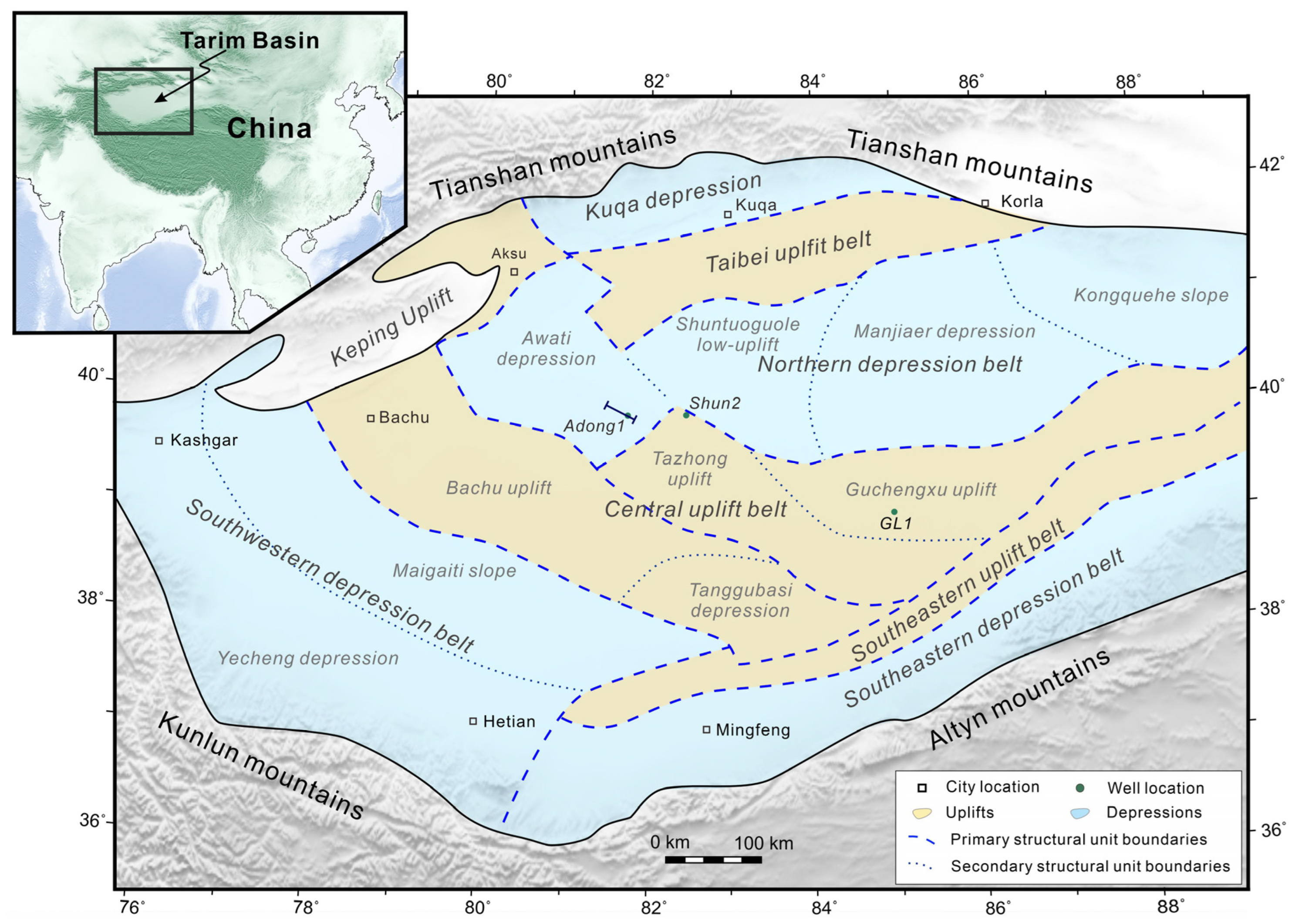
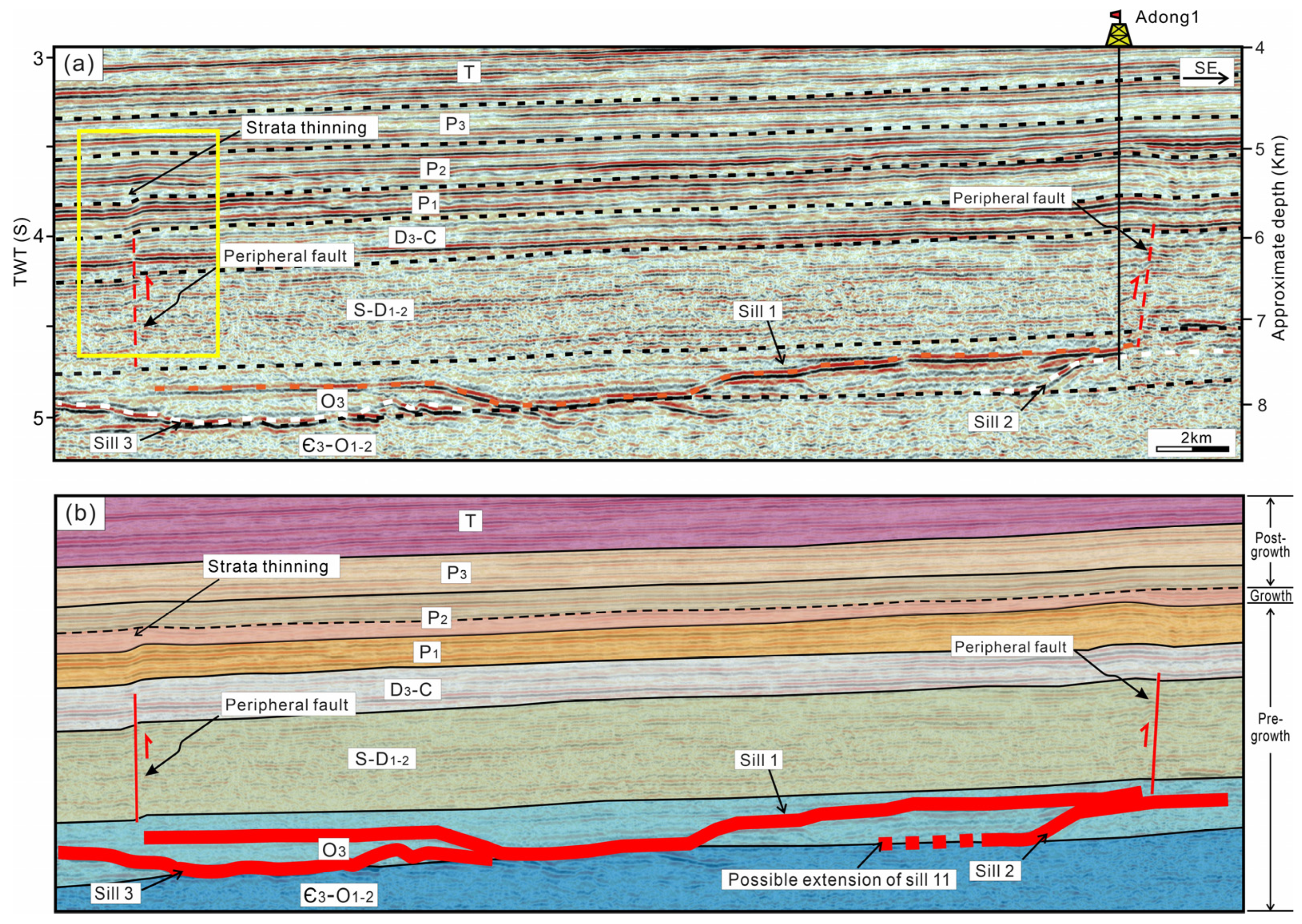
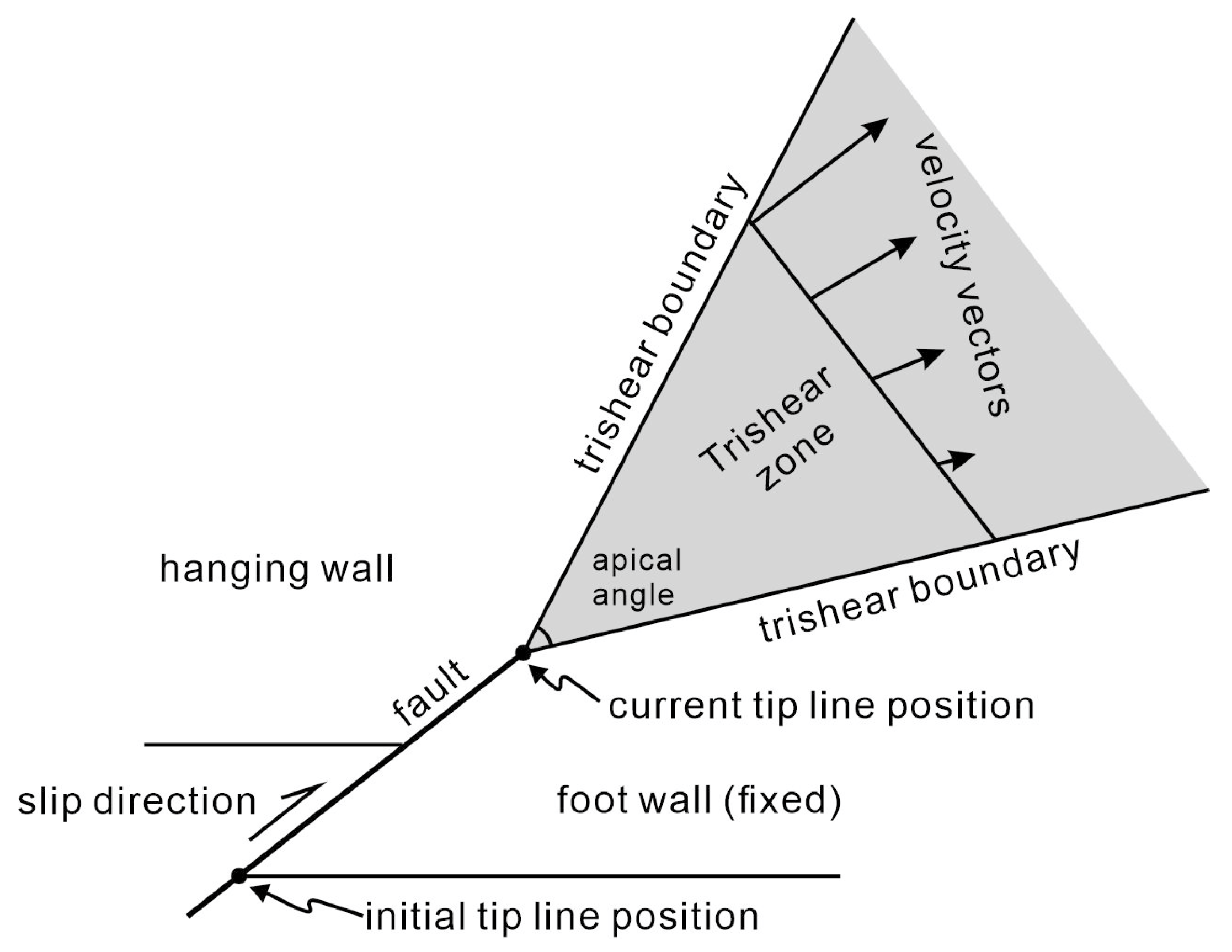

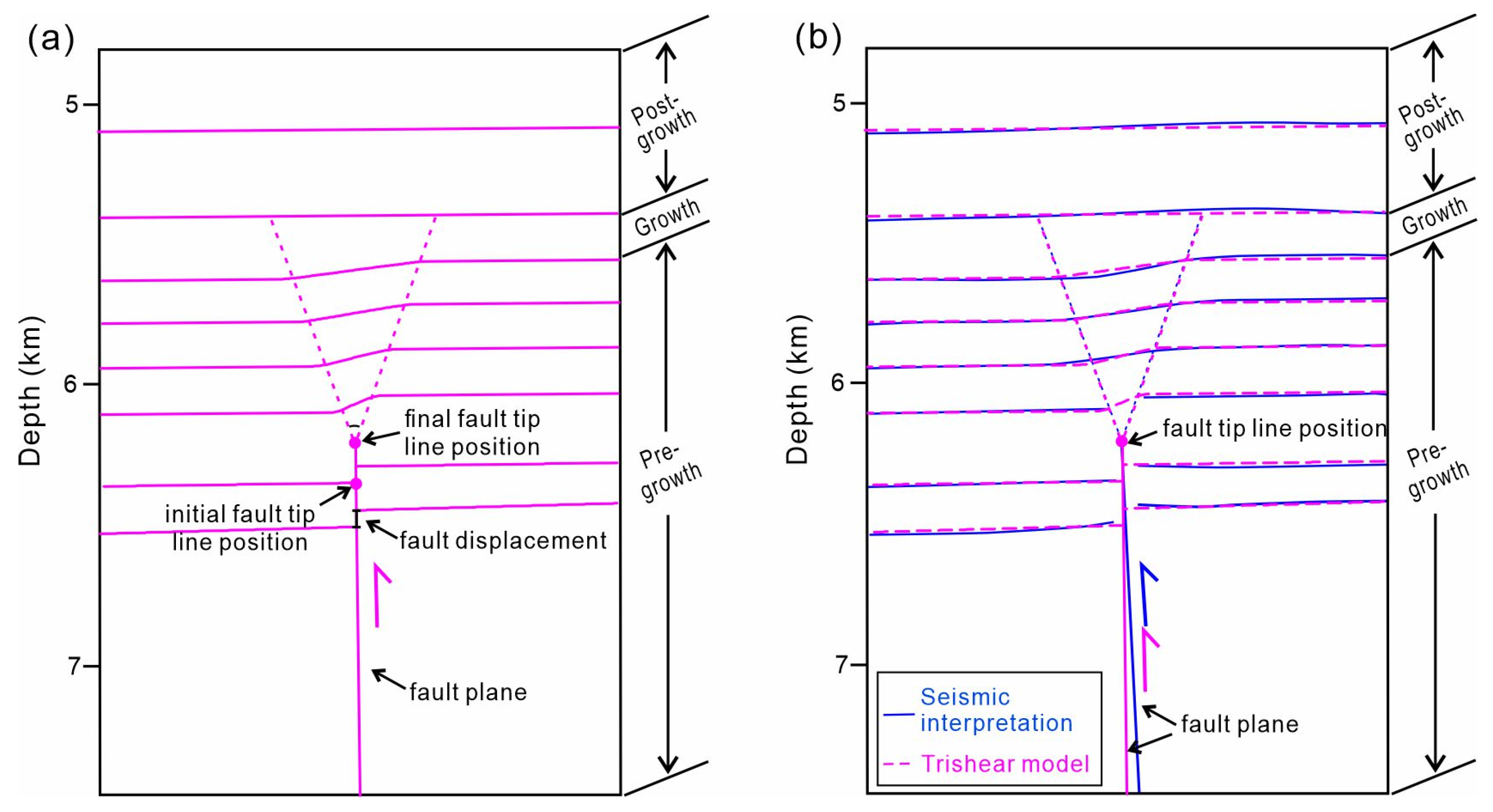
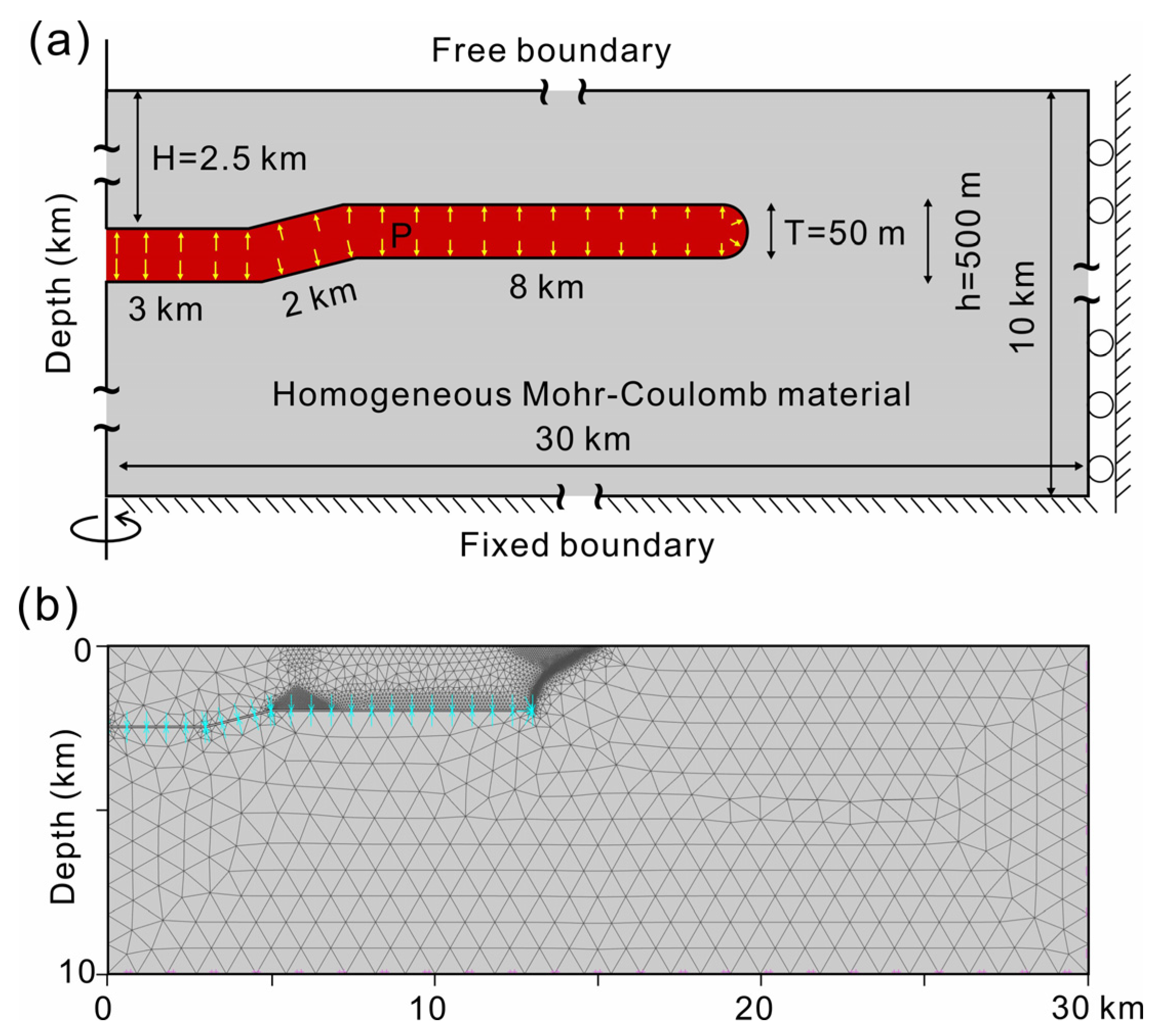

| Seismic Interpretation | Kinematic Model | |
|---|---|---|
| Trishear apical angle | 40° | 40° 1 |
| Displacement | 52 m | 58 m |
| Dip angle | 88° | 90° |
| P/S ratio | / | 2.5 |
| Symbol | Parameter Definition | Value |
|---|---|---|
| ρ | Density (kg/m3) | 2.5 × 103 |
| C | Cohesion (MPa) | 20 |
| φ | internal friction angle (°) | 30° |
| E | Young′s modulus (GPa) | 20 |
| ν | Poisson′s ratio | 0.25 |
Disclaimer/Publisher’s Note: The statements, opinions and data contained in all publications are solely those of the individual author(s) and contributor(s) and not of MDPI and/or the editor(s). MDPI and/or the editor(s) disclaim responsibility for any injury to people or property resulting from any ideas, methods, instructions or products referred to in the content. |
© 2024 by the author. Licensee MDPI, Basel, Switzerland. This article is an open access article distributed under the terms and conditions of the Creative Commons Attribution (CC BY) license (https://creativecommons.org/licenses/by/4.0/).
Share and Cite
Yao, Z. Constraints on the Geometry of Peripheral Faults above Mafic Sills in the Tarim Basin, China: Kinematic and Mechanical Approaches. Appl. Sci. 2024, 14, 8621. https://doi.org/10.3390/app14198621
Yao Z. Constraints on the Geometry of Peripheral Faults above Mafic Sills in the Tarim Basin, China: Kinematic and Mechanical Approaches. Applied Sciences. 2024; 14(19):8621. https://doi.org/10.3390/app14198621
Chicago/Turabian StyleYao, Zewei. 2024. "Constraints on the Geometry of Peripheral Faults above Mafic Sills in the Tarim Basin, China: Kinematic and Mechanical Approaches" Applied Sciences 14, no. 19: 8621. https://doi.org/10.3390/app14198621






